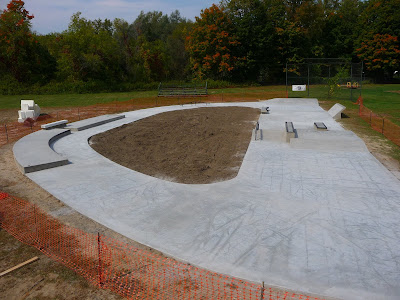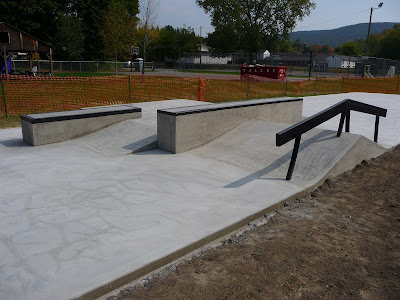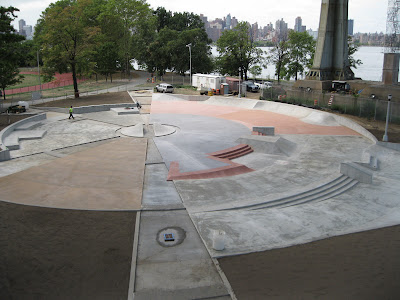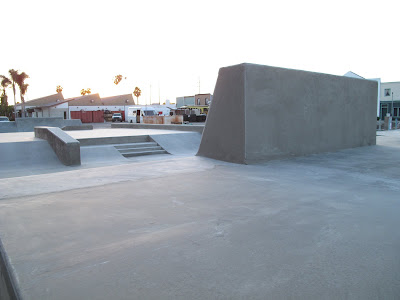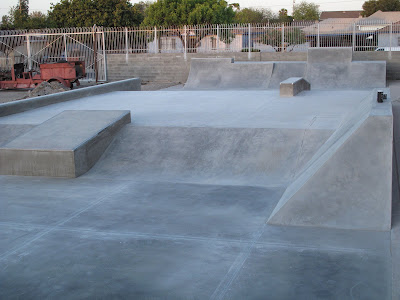Skateboarder Philipp Schuster turned an abandoned hunting lodge into a skate-able home. Pretty cool. See more photos and read the article on Dezeen.
Philipp Schuster Skate House
February 4, 2013
RIP Bubble banks
January 25, 2013
Brower Park skatepark addition
January 19, 2013
 |
| Brower Park Rendering of proposed Bank to Ledge. |
Check out some of the Crown Heights skateboarders at Brower Park here.
Tracy Johnson is an inspiration- read this article about her here were you can watch a video of her skateboard team.
 |
| Rendering of LaSalle Park Skatepark by New Line |
 |
| Location of LaSalle Park Skatepark |
My photos from the pre-bid meeting:

|

|

|
Concept designs by New Line:

|
New Who Skates Logo Sneak Peek!
January 14, 2013
As you all may have noticed there hasn't been a post on this blog in almost a year. We've had a lot of changes at the Who Skates drawing board and one awesome thing that I've recently decided is that we're going to get this blog back in action and keep it interesting!!
A creative friend of mine is working on some new marketing material for us and here is a sneak peak of one of the logo ideas she made. I'm loving the retro look of the background in this one! I'll post some more tomorrow for y'all to see after I get to Buffalo to check out a potential new Who Skates park. I'm psyched that we will have some great Who Skates gear we can sport at all the skate parks soon.
A creative friend of mine is working on some new marketing material for us and here is a sneak peak of one of the logo ideas she made. I'm loving the retro look of the background in this one! I'll post some more tomorrow for y'all to see after I get to Buffalo to check out a potential new Who Skates park. I'm psyched that we will have some great Who Skates gear we can sport at all the skate parks soon.
Stranger than fiction...
January 26, 2012
"Do not consider it proof just because it is written in books, for one who will deceive with his tongue will not hesitate to do the same with his pen." Maimonides
The time has come- the time to tell your city that temporary steel ramps are NOT what skaters want. The Tony Hawk Foundation has eliminated ALL funding for prefab or precast parks with kickplates, Skaters for Public Skateparks and SPAUSA have openly supported concrete installations and even going back to 2004 many had already began to question the reality of a 20 year warranty and such easy setup... and for good reason.
But let's get down to brass tacks with our top 10 myths regarding prefab skateparks-
- Prefab has a 20 year warranty
- Your climate is too cold for concrete
- Your soils won't support a concrete skatepark
- Your budget is too small for concrete
- You can move the park if it's not successful
- You can't move a concrete park around ( of course we feel that if your park is designed by professionals then you won't NEED to move it around)
- Prefab is quicker and the kids will be skating sooner
- Prefab isn't noisy but in case you want it "we offer a noise-reducing package for $$$"
- Prefab is cheaper
- prefab designs are FREE...
Simple fact is that prefab is an archaic type of skatepark and which has enjoyed sufficient time in the limelight- we need to band together to help usher in the new-normal where all kids are given an opportunity at a great park, no matter the size.
Help us in our fight for all public skateparks to be concrete- designed by skaters, built by skaters and used by skaters.
The time has come- the time to tell your city that temporary steel ramps are NOT what skaters want. The Tony Hawk Foundation has eliminated ALL funding for prefab or precast parks with kickplates, Skaters for Public Skateparks and SPAUSA have openly supported concrete installations and even going back to 2004 many had already began to question the reality of a 20 year warranty and such easy setup... and for good reason.
But let's get down to brass tacks with our top 10 myths regarding prefab skateparks-
- Prefab has a 20 year warranty
- Your climate is too cold for concrete
- Your soils won't support a concrete skatepark
- Your budget is too small for concrete
- You can move the park if it's not successful
- You can't move a concrete park around ( of course we feel that if your park is designed by professionals then you won't NEED to move it around)
- Prefab is quicker and the kids will be skating sooner
- Prefab isn't noisy but in case you want it "we offer a noise-reducing package for $$$"
- Prefab is cheaper
- prefab designs are FREE...
Simple fact is that prefab is an archaic type of skatepark and which has enjoyed sufficient time in the limelight- we need to band together to help usher in the new-normal where all kids are given an opportunity at a great park, no matter the size.
Help us in our fight for all public skateparks to be concrete- designed by skaters, built by skaters and used by skaters.
Labels:
prefab skateparks,
skate park,
skateboard,
skatepark,
who,
who skates
What does a sawdust burger have to do with skateparks?
September 2, 2011
ring-ring... ring-ring... “hello, City of Anytown, how can I help you?”
“I have some questions regarding he skatepark bid, who might I speak with?”
“That would be Jeremiah, please hold”
“Hello, this is Jeremiah”
“Hi Jeremiah, I was reading the bid and was curious why you would be building a temporary steel park rather than a permanent, professionally-built concrete one?”
“Simple- warranty and cost. Concrete isn’t warranted and it costs three times as much as steel”.
Awkward silence...
“Well, then can you tell me why the bid spec for the ramps is written by the vendor and eliminates anyone else form bidding?"
"Because”, Jeremiah offered, “it’s just the industry standard...”
More awkward silence...
In the 30 minutes that followed Jeremiah grew more and more angry at the fact that this company, whom they had chosen to lead the skatepark design process with their community, had actually abused that trust and used it as an opportunity to create a no-bid sale of their product- despite the fact that the project is funded entirely by tax-generated funds- your and my hard-earned tax dollars.
The process has become more and more common in our industry with one company working tirelessly to create a list of requirements- from insurance limits to warranties to the use of copyrighted names to put themselves at the top of some self-invented heap in a game of marketing at the expense of quality. So the question begs- does a copyrighted name that only one vendor has the right to use make a better product? How about upping the length of your warranty to more than twice the length of time your company has ben in business and 5 times that of a Mercedes? In my opinion, none of this makes shit for a difference when the time comes to skating... and we are building a skatepark, right?
Proprietary Specs and the abuse of trust
There are many ways to gain the trust of a client- reputation, history of quality and timeliness, length of time in business, etc. There may even be religious values that draw you to a particular company over another or, gasp, their brochure just looked real good and had LOTS of completed projects and quotes... but why anyone trusts a particular salesman and chooses a particular product isn’t the real issue, we are discussing what someone does with that trust.
Skateparks are strange, abstract little beasts and to the non-skater, which the vast majority of city officials responsible for buying one are, it can be a very scary endeavor. That said, once a the aforementioned official develops a level of trust with the salesman things can move along pretty quickly. And now we arrive at the problem- when the salesman abuses that trust and pigeon-holes their product in to the process.
Development of product and competition, it has been said, is the cornerstone of creativity. But what about the development of specifications and procedures which don’t create a better product but simply serve to create a monopoly. And what happens when that monopoly is presented in such a way that those who don’t offer the same product are somehow inferior? Seriously? Because every restaurant in America isn’t willing to cook up sawdust burgers the one who does is the automatic winner? “Well, our sawdust burger is the best in the world and we’re the only ones doing it!” Do you see a problem here, Clem? Your burger isn’t the best... as a matter of fact it isn’t even any good at all but with enough marketing dollars and a little help from above even a sawdust burger can burst on to the scene and lead the industry for a while.
Of course all good (or bad) things must come to an end and so it will go for Clem’s sawdust burger- but I’m sure by then Clem will have bought another restaurant and try and find a way to create something else that no one really wants, like sawdust dog food or sawdust pillows...
“I have some questions regarding he skatepark bid, who might I speak with?”
“That would be Jeremiah, please hold”
“Hello, this is Jeremiah”
“Hi Jeremiah, I was reading the bid and was curious why you would be building a temporary steel park rather than a permanent, professionally-built concrete one?”
“Simple- warranty and cost. Concrete isn’t warranted and it costs three times as much as steel”.
Awkward silence...
“Well, then can you tell me why the bid spec for the ramps is written by the vendor and eliminates anyone else form bidding?"
"Because”, Jeremiah offered, “it’s just the industry standard...”
More awkward silence...
In the 30 minutes that followed Jeremiah grew more and more angry at the fact that this company, whom they had chosen to lead the skatepark design process with their community, had actually abused that trust and used it as an opportunity to create a no-bid sale of their product- despite the fact that the project is funded entirely by tax-generated funds- your and my hard-earned tax dollars.
The process has become more and more common in our industry with one company working tirelessly to create a list of requirements- from insurance limits to warranties to the use of copyrighted names to put themselves at the top of some self-invented heap in a game of marketing at the expense of quality. So the question begs- does a copyrighted name that only one vendor has the right to use make a better product? How about upping the length of your warranty to more than twice the length of time your company has ben in business and 5 times that of a Mercedes? In my opinion, none of this makes shit for a difference when the time comes to skating... and we are building a skatepark, right?
Proprietary Specs and the abuse of trust
There are many ways to gain the trust of a client- reputation, history of quality and timeliness, length of time in business, etc. There may even be religious values that draw you to a particular company over another or, gasp, their brochure just looked real good and had LOTS of completed projects and quotes... but why anyone trusts a particular salesman and chooses a particular product isn’t the real issue, we are discussing what someone does with that trust.
Skateparks are strange, abstract little beasts and to the non-skater, which the vast majority of city officials responsible for buying one are, it can be a very scary endeavor. That said, once a the aforementioned official develops a level of trust with the salesman things can move along pretty quickly. And now we arrive at the problem- when the salesman abuses that trust and pigeon-holes their product in to the process.
Development of product and competition, it has been said, is the cornerstone of creativity. But what about the development of specifications and procedures which don’t create a better product but simply serve to create a monopoly. And what happens when that monopoly is presented in such a way that those who don’t offer the same product are somehow inferior? Seriously? Because every restaurant in America isn’t willing to cook up sawdust burgers the one who does is the automatic winner? “Well, our sawdust burger is the best in the world and we’re the only ones doing it!” Do you see a problem here, Clem? Your burger isn’t the best... as a matter of fact it isn’t even any good at all but with enough marketing dollars and a little help from above even a sawdust burger can burst on to the scene and lead the industry for a while.
Of course all good (or bad) things must come to an end and so it will go for Clem’s sawdust burger- but I’m sure by then Clem will have bought another restaurant and try and find a way to create something else that no one really wants, like sawdust dog food or sawdust pillows...
Fair is fair, it's time for a new look at public recreation...
August 24, 2011


I want to know why, in most case, baseball diamonds have been built and maintained, without complaint, by taxpayers for decades. When is the last time you saw a trash receptacle tipped over or overflowing at a baseball field after a big game? It's a pretty common site where I'm from. Do the residents complain that the baseball players are belligerent, disrespectful punks and the field should be shut down? No, the taxpayer-funded DPW walks out there like they always do and clean it up... So, why is it that news articles pop up every day regarding fences, monitors and "punishment" closings at skateparks for the same things? I can see the headline now "SKATEPARK CLOSED BECAUSE OF TRASH PROBLEMS"... "we decided to close the skatepark until these kids can learn to respect it and pick up after themselves"... yea, just like the baseball players, right!!!

Now, simple math gives us another look at this- three DPW employees in two trucks for approximately 2 hours totals about $400 out of the coffers every time the field needs to be picked up. Multiply that by 15 weeks and you get what, $6,000 in trash pickup alone for one baseball diamond? Seriously? And let's not forget the public space necessary for a baseball diamond. When a skatepark committee is fighting for 3,000 or 4,000 square feet for a skatepark the ball fields take up more than ten times that... Baseball diamonds don't get crammed in behind the police station, they don't get an old40 year old tennis court (because the Town is spending $90,000 on a new one to replace the bad one) and they don't a tiny sliver of land next to the new dog park... baseball diamonds get the prime land, they get all the funds and they get all the exposure- all so that a bunch of kids can play the Nations pastime for two months... now, I love baseball as much as the next guy (not really but it sounded good) but when is fair fair?

Oh, and when was the last time you heard anyone complain about a baseball diamond being mowed two or three times a week at the taxpayers expense? The average public ball field or city park costs $9,000 per year to mow and maintain, without figuring in the cost of the $30,000 mower...

Skateparks are becoming a necessary element in towns across America and it's time public officials start recognizing the need for at least ONE skatepark in town- especially when there are already multiple tennis, baseball, football, basketball and running facilities.
Over and out...
It's been a while since I last ranted but it's been a busy summer. Today I'd like to get to the bottom of why the hell city officials and parents think skateaprks need to be monitored... and to a greater extent why public money should be spent on skateparks to begin with... so here we go-
First, people need to realize that the sports we recognized as "normal" are changing as fast as the times. Kids are less interested in tennis, basketball, baseball and other sports (with multiple places to practice in most towns) and more interested in the sports they see on MTV, video games and other age-specific programming. When's the last time your kid wanted to run to Best buy to buy BORIS BECKERS PRO TENNIS PLAYER or TIGER'S PRO GOLFER? Tony Hawks pro Skater is one of the top selling games of all time for a reason, stop making these kids feel like outcasts because they don't want to participate in your idea of "proper sports"... municipalities need to adjust with the times and provide kids with the outlets they need instead of building more tennis courts when there are already a dozen in most towns.
Next, the type of facility will dictate what type of use it gets. Buying prefab ramps from a catalog and plunking them on a tennis court is NOT a skatepark. This type of park results in more trash, less traffic and a much more limited user base than a professionally-designed concrete park designed for all ages- yes, adults do skate and create a structured atmosphere with constant mentoring- remove the adults and you have immediate problems.... Steel skateparks are like paving a baseball diamond or building a tennis court on a hillside, it's just wrong.
And lastly, why does everyone always assume a skatepark needs supervision? Are skaters genetically predisposed to trouble and does putting them inside a fenced area with some intern shouting at them going to suddenly set them straight? No... it won't, that's called school. A skatepark should be cutting edge and attract users of all ages and abilities. And, just like your publicly-funded playgrounds on public land, It should NOT be fenced. It should be designed as an integral part of the landscape and disappear to most passers-by if there are no skaters there. Picture a beautiful little park-inside-a-park with trees and benches that was designed to be skated- there is no noise, no circus show... now picture a fenced tennis court with noisy steel ramps and a gate- it's noisy, looks like an MMA fighting ring and sounds like an elementary school band practicing inside of a steel drum...
SO, do your research, open your minds and stop thinking that skaters are any different than any other athlete. But also give some real consideration to your own prejudices about them... if your neighbors kid was a star football player you'd wave and say what a good kid he is but change his clothes and put a skateboard under his arm and you'd be locking your doors at night... and that's just wrong.
Oh yea, I still have questions- I do have to ask if the local playgrounds, ball fields and such are supervised in your town? Can kids go to a local park and play soccer without a supervisor keeping them safe? Are the basketball courts monitored? Can kids toss a frisbee in a public park? Is there a monitor at the local tot-lot or is the supervision of all of these facilities at the parents risk? I think the problem lies in fears that skating should be treated differently than other sports. If a group of teens can go to a basketball court and play barefoot, drink out of glass containers and not wear eye protection than kids should be able to enjoy a skatepark without "the man" watching... RESPECTFULLY submitted, I appreciate the points of view.
First, people need to realize that the sports we recognized as "normal" are changing as fast as the times. Kids are less interested in tennis, basketball, baseball and other sports (with multiple places to practice in most towns) and more interested in the sports they see on MTV, video games and other age-specific programming. When's the last time your kid wanted to run to Best buy to buy BORIS BECKERS PRO TENNIS PLAYER or TIGER'S PRO GOLFER? Tony Hawks pro Skater is one of the top selling games of all time for a reason, stop making these kids feel like outcasts because they don't want to participate in your idea of "proper sports"... municipalities need to adjust with the times and provide kids with the outlets they need instead of building more tennis courts when there are already a dozen in most towns.
Next, the type of facility will dictate what type of use it gets. Buying prefab ramps from a catalog and plunking them on a tennis court is NOT a skatepark. This type of park results in more trash, less traffic and a much more limited user base than a professionally-designed concrete park designed for all ages- yes, adults do skate and create a structured atmosphere with constant mentoring- remove the adults and you have immediate problems.... Steel skateparks are like paving a baseball diamond or building a tennis court on a hillside, it's just wrong.
And lastly, why does everyone always assume a skatepark needs supervision? Are skaters genetically predisposed to trouble and does putting them inside a fenced area with some intern shouting at them going to suddenly set them straight? No... it won't, that's called school. A skatepark should be cutting edge and attract users of all ages and abilities. And, just like your publicly-funded playgrounds on public land, It should NOT be fenced. It should be designed as an integral part of the landscape and disappear to most passers-by if there are no skaters there. Picture a beautiful little park-inside-a-park with trees and benches that was designed to be skated- there is no noise, no circus show... now picture a fenced tennis court with noisy steel ramps and a gate- it's noisy, looks like an MMA fighting ring and sounds like an elementary school band practicing inside of a steel drum...
SO, do your research, open your minds and stop thinking that skaters are any different than any other athlete. But also give some real consideration to your own prejudices about them... if your neighbors kid was a star football player you'd wave and say what a good kid he is but change his clothes and put a skateboard under his arm and you'd be locking your doors at night... and that's just wrong.
Oh yea, I still have questions- I do have to ask if the local playgrounds, ball fields and such are supervised in your town? Can kids go to a local park and play soccer without a supervisor keeping them safe? Are the basketball courts monitored? Can kids toss a frisbee in a public park? Is there a monitor at the local tot-lot or is the supervision of all of these facilities at the parents risk? I think the problem lies in fears that skating should be treated differently than other sports. If a group of teens can go to a basketball court and play barefoot, drink out of glass containers and not wear eye protection than kids should be able to enjoy a skatepark without "the man" watching... RESPECTFULLY submitted, I appreciate the points of view.
Lee Mass Plaza
September 24, 2010
Colerain Township, Ohio
August 27, 2010
What makes WHO tick?
August 17, 2010

In a move sure to shake the skatepark world up a bit, the Tony Hawk Foundation (who is responsible for grants to communities to build skateparks) has changed their rules to apply only to poured in place concrete parks, with a few exceptions.
In an incredible move, the THF is showing their support for skateparks that will promote our sport, create new users and dramatically reduce the temporary prefab parks our kids are forced to skate.
Thank you THF for supporting skating all of these years and thank you THF for taking the next step to ensure skating not only survives but thrives in years to come!!
Watts Project- Los Angeles, California
April 18, 2010
Subscribe to:
Comments (Atom)








